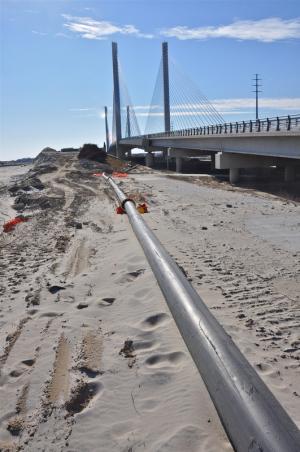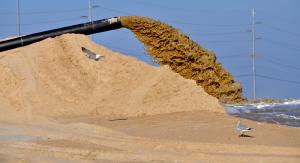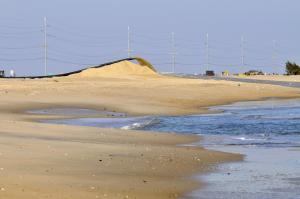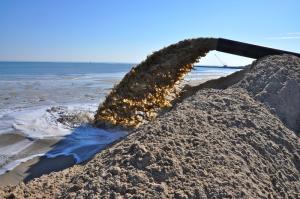Pumping under way at Indian River Inlet
A sand-pumping system at Indian River Inlet damaged during superstorm Sandy is now back in operation, moving sand from the south side of the inlet to the north side.
Pumping is needed to widen the inlet's northside beach, which in turn protects the northside approach to the Indian River Inlet bridge.
State officials say they plan to seek federal disaster relief supplemental funding expected in the wake of Sandy – putting the bridge project in competition with all projects seeking supplemental relief, including funds to rebuild the dunes and widen Fowler Beach in Prime Hook National Wildlife Refuge.
Dan Brower, program manager in the Department of Natural Resources and Environmental Control's waterways and shoreline management section, said the natural flow of sand along Delaware's Atlantic coast is from south to north. Jetties constructed in the 1930s to stabilize Indian River Inlet interrupt the natural flow, trapping sand on the south side of the inlet. In some years, the sand deficit is dramatic. By pumping sand over the bridge, he said, “We are doing what nature would normally do on its own.”
The pumping operation moves more than 100,000 cubic yards of sand annually across the Indian River Inlet bridge to rebuild the dunes and beaches near the inlet, Brower said. More than 25,000 cubic yards had been pumped, starting in September, when Hurricane Sandy damaged a new pumping system built as part of the bridge project.
Storm surge and sand overwashed Route 1 north of the bridge forcing DelDOT officials to close the bridge from Oct. 28 to Nov. 4 as crews removed more than 6 million cubic yards of sand from the roadway.
|
2009: 103,918 2010: 128,287 2011: 123,425 2012: 114,560, 25,000 cubic yards since September. How much is a cubic yard? A cubic yard of sand weighs about 2,500 pounds and is about two scoops of a front end loader. |
Douglass Robb, DelDOT bridge engineer, said DelDOT and DNREC staff are working on a plan to provide better protection for Route 1.
He said DelDOT would provide more details on a project using corrugated metal sheet piling to protect an 800- to 1,000-foot-long section of roadway just north of the bridge. “We need to make it clear that our immediate efforts are solely intended to provide some added level of protection to a relatively localized area,” Robb said. “Our goal is to prevent a pavement failure that might otherwise cause extended roadway closures near the bridge as a result of future storms.”
Robb noted the larger issue of dune stabilization is not in DelDOT's jurisdiction, but under DNREC's domain.
During a recent talk to the Rehoboth Beach-Dewey Beach Chamber of Commerce, DelDOT Secretary Shailen Bhatt said reaching a total solution involves three agencies. DelDOT is responsible for the roadbed and bridge; DNREC is responsible for the dunes and sand; and the Army Corps of Engineers is responsible for the Indian River Inlet.
Corps would request funding
DNREC is in the process of providing data on the loss to the corps to be added to the corps' request for supplemental disaster aid funding from Congress, said Tony Pratt, administration of DNREC's shoreline and waterway management section. It's the same pot of money from which the state is seeking $20 million to restore Fowler Beach at Prime Hook National Wildlife Refuge. The money would be used to repair hurricane damage and provide more protection to the community of Primehook Beach.
Pratt said DNREC wants the corps to restore the beach along Route 1 north of the bridge to the same type of system in resort towns like Rehoboth Beach: 100-foot wide dune and 200-foot beach. “We could then maintain that profile with the bypass system; that's the way the system was supposed to work,” Pratt said.
Pratt said he wished he could put a timeline on a possible project. “We have a weakened defense system that we need to address as soon as possible,” Pratt said.
Sand bypass system in place 20 years
Sand pumping – scheduled from Labor Day to Memorial Day – occurs during work-day hours; two trained DNREC shoreline and waterway management workers are required to operate the system. One operates the crane while the other monitors the controls in a nearby building. A third person is sometimes necessary to operate a front-end loader, said DNREC spokesman Michael Globetti.
Because so many people use the beach during the summer, sand is not pumped. Brower said DNREC staff might look at a possible change in that policy.
The bypass system is made up of a crane situated along the inlet's south shore – the Bethany Beach side – that holds an eductor, or jet pump, in the surf zone. Through a pump house, the sand is sucked up the eductor and pushed through a pipe attached to the bridge to the north side, where it is deposited close to the surf to rebuild the beach.

























































